American Idiot at 20: An Off-Balance Retrospective.
Two decades since its release, Green Day's 2004 album endures.
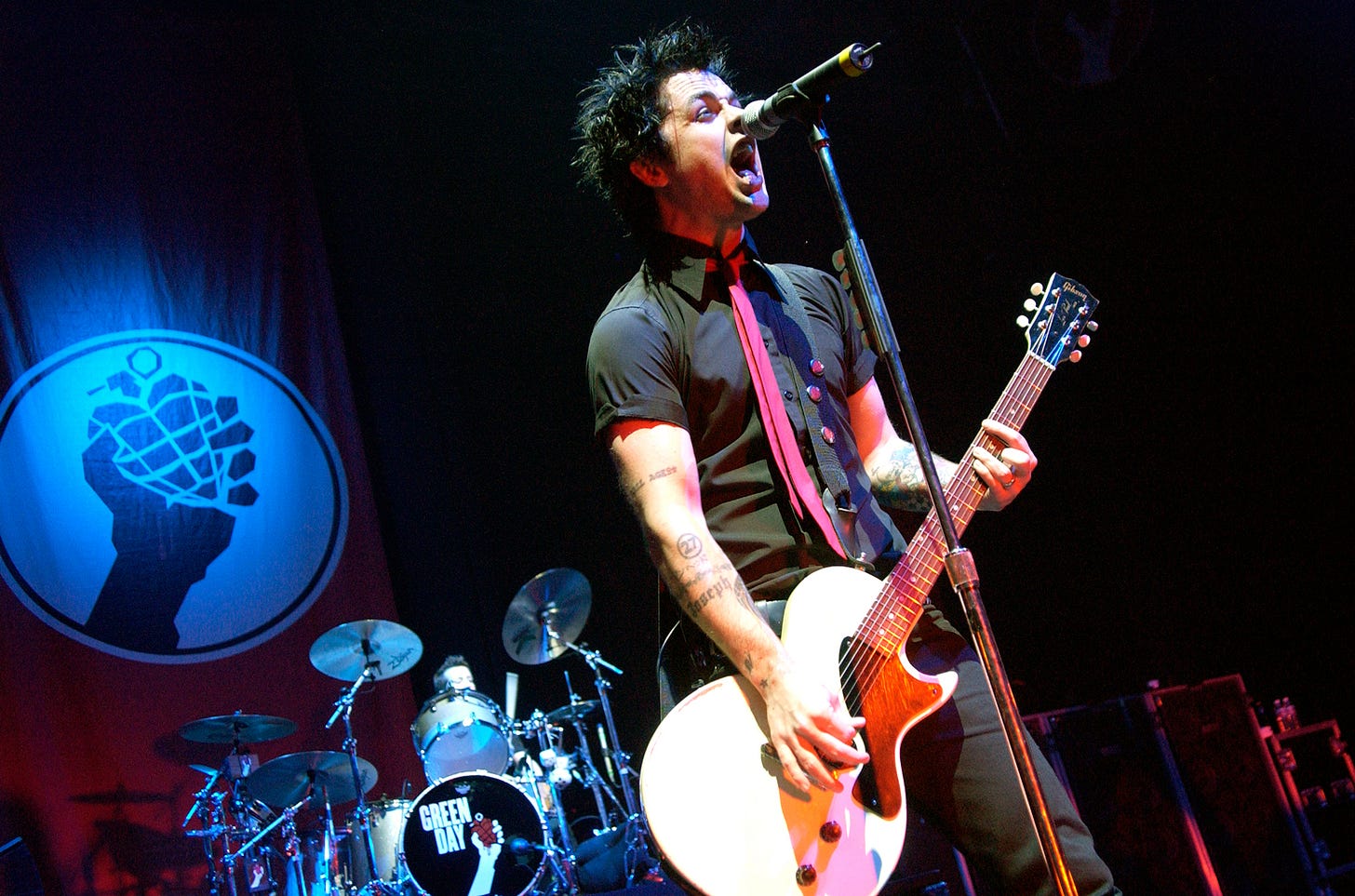
So the story goes, after the masters for their long-in-development project, “Cigarettes and Valentines” were stolen from the studio, Green Day found themselves at something of a creative crossroads. They were already twenty songs deep, in most cases, an entire album’s worth of material.
But rather than simply re-record everything wholesale, they decided to start completely fresh.
New album, new music, new approach.1
The result was 2004’s American Idiot, which is, depending on who you ask, the band’s magnum opus. Their seventh album, clocking in at just under an hour. A colourful, angsty-burst of punk-rock infused, politically-charged storytelling which, from beginning to end, fires on all cylinders.
And as we arrive at twenty years since its release this September?
Well, it seemed like a prime opportunity to take a look back.
It is an album that is not just a cultural touchstone for an entire generation but also, one that has shown itself to have substantial creative legs as well.
Being strikingly relevant in this, our current climate, while at the same time, existing very much as a product of its period too.
Let’s rock.
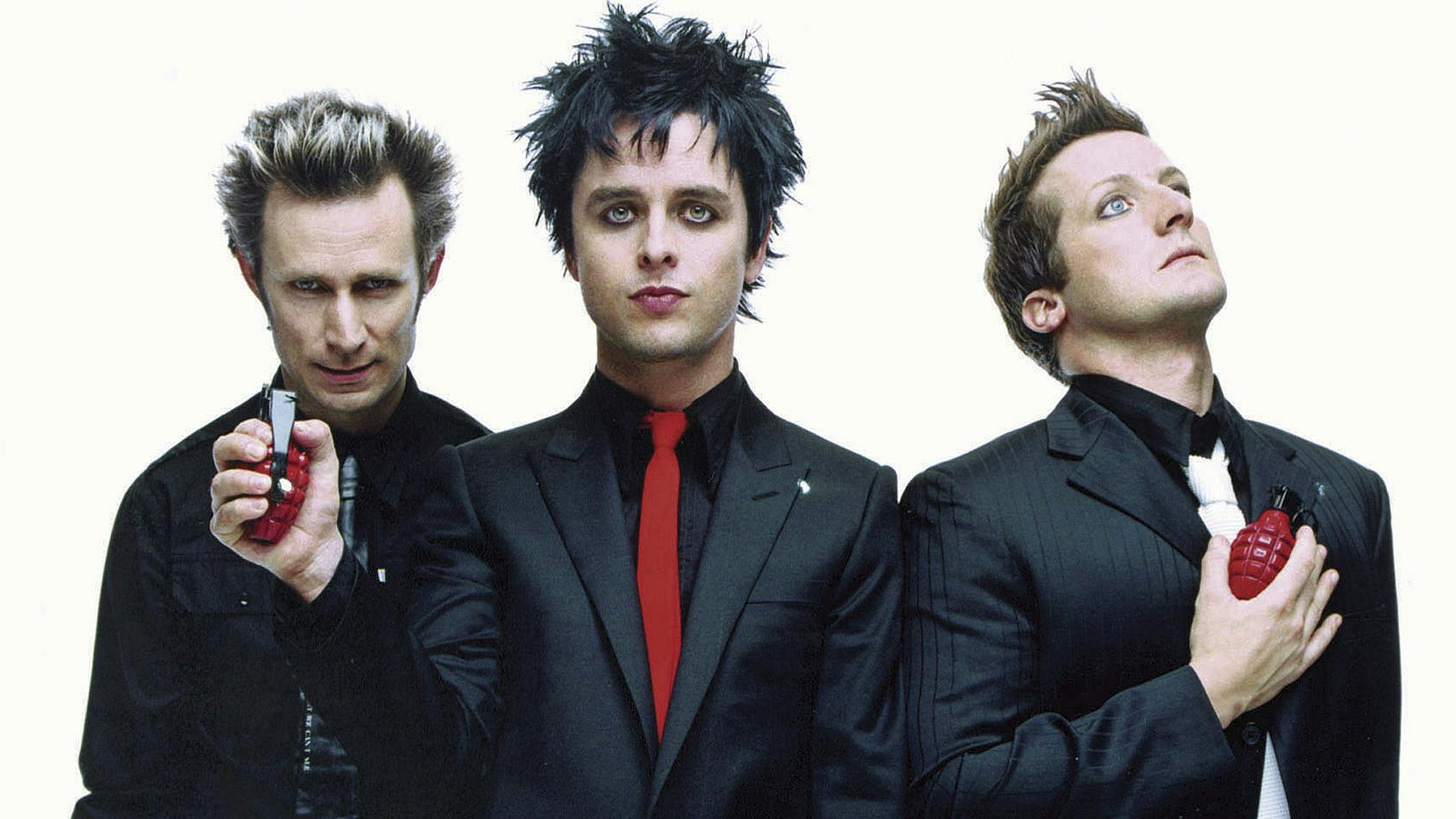
Though it can be easy, when analyzing a work of such outsized influence, to do so in something of a vacuum, with American Idiot, it helps to understand just what brought Green Day to that intersection in the first place: musically, lyrically and in terms of reshaping their larger cultural profile.
And although the band’s earliest years, were, like so many before them, a living work-in-progress, from the get-go, their talent was evident.
After meeting in grade school, Billie Joe Armstrong and Mike Dirnt would immediately bond over their shared love of music. Come 1987? They had formed Sweet Children, although by their own admission, it didn’t take.
Within two years, they were, instead, Green Day.
The new name, unabashedly, a nod to their fondness for pot.
After rotating through a series of drummers, by the time their second album, Kerplunk, was released in 1991, Dirnt and Armstrong, still teenagers themselves, had found their permanent third: Tré Cool, who, while only nineteen, had been steadily building a reputation on the local circuit for many years.
Though even with their lineup solidified, Green Day also found themselves caught in the crossfire of the “true punk” discourse. From their musical style, to their climbing of the ladder as they went from Bay Area unknowns to a band rapidly on the rise.
Consider: after signing with Reprise? They were blacklisted from 924 Gilman, the legendary underground club in Berkeley which had seen them through their earliest years. The trio, thereafter, branded as “sellouts” (hindsight though, is understanding that the band’s breakout was inevitable - they would notably return to Gilman, more than once, as their ban was lifted).
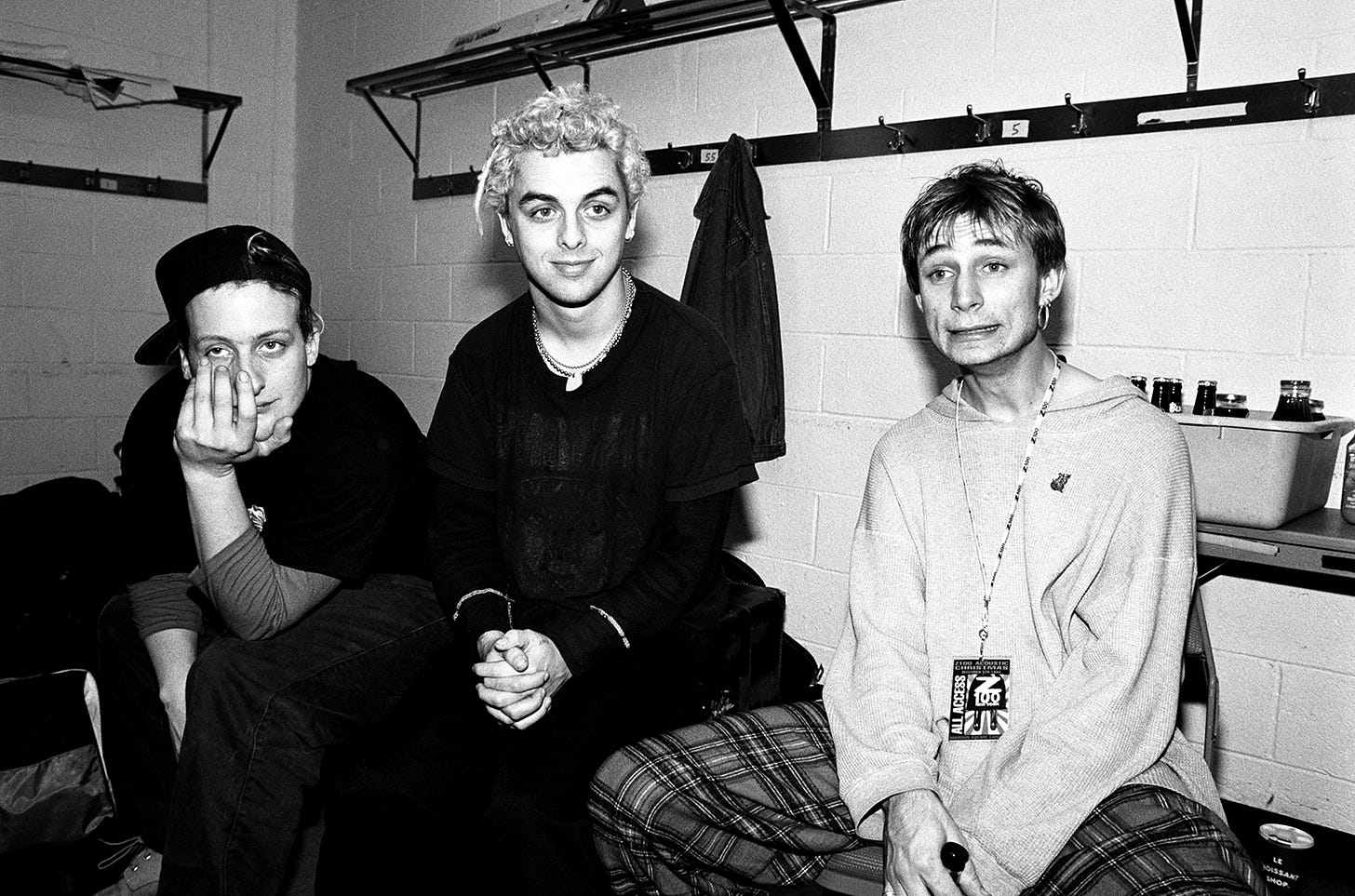
And sellouts or not, 1994’s Dookie, their major-label debut, would launch Green Day into global superstardom.
Recorded in three weeks, it was the perfect pairing of their backroom punk energy and a cleaner, more produced sound (particularly when compared to their earliest material).
Dirnt’s cool bass, the connective tissue between Cool’s up-tempo kit work, Armstrong’s high-intensity guitar playing and personal-experience driven songwriting: covering everything from sex and drug use, to abusive relationships and self-acceptance.
They would win a Grammy, in time, sell some twenty million records and firmly establish themselves as not just the new face of the ‘90s alternative music movement, as it moved outside of grunge’s orbit but as the punk outfit of record.
And while none of their three follow-up efforts (Insomniac, Nimrod, Warning) would reach similar levels of success, their pure creative growth, project-to-project is unmistakable. From the complexity and content of their lyricism, incorporating outside genre influences to the experimentation that can heard in their evolving musicianship.
It is then, with this context front of mind, what makes the Cigarettes and Valentines to American Idiot period so intriguing.
In a profile with Rolling Stone published in February of 2005, the band spoke to the fact that, come the early-2000s, their personal relationships had long been deteriorating, amid apathetic and waning creative inspiration.
Splitting up the band, going their separate ways, was considered.
So in starting over, post-Valentines theft, they were forced to reevaluate. Reigning themselves back in, returning to the studio and embracing the maturity they had found but often seemed reluctant to master - while still being, unapologetically, themselves.
I felt like I was too old to be angry anymore. I didn't want to come across as the angry older guy. It's sexy to be an angry young man but to be a bitter old bastard is another thing altogether.
Billie Joe Armstrong, speaking to Rolling Stone in 2005, regarding his growth, musically and personally, following American Idiot’s release.
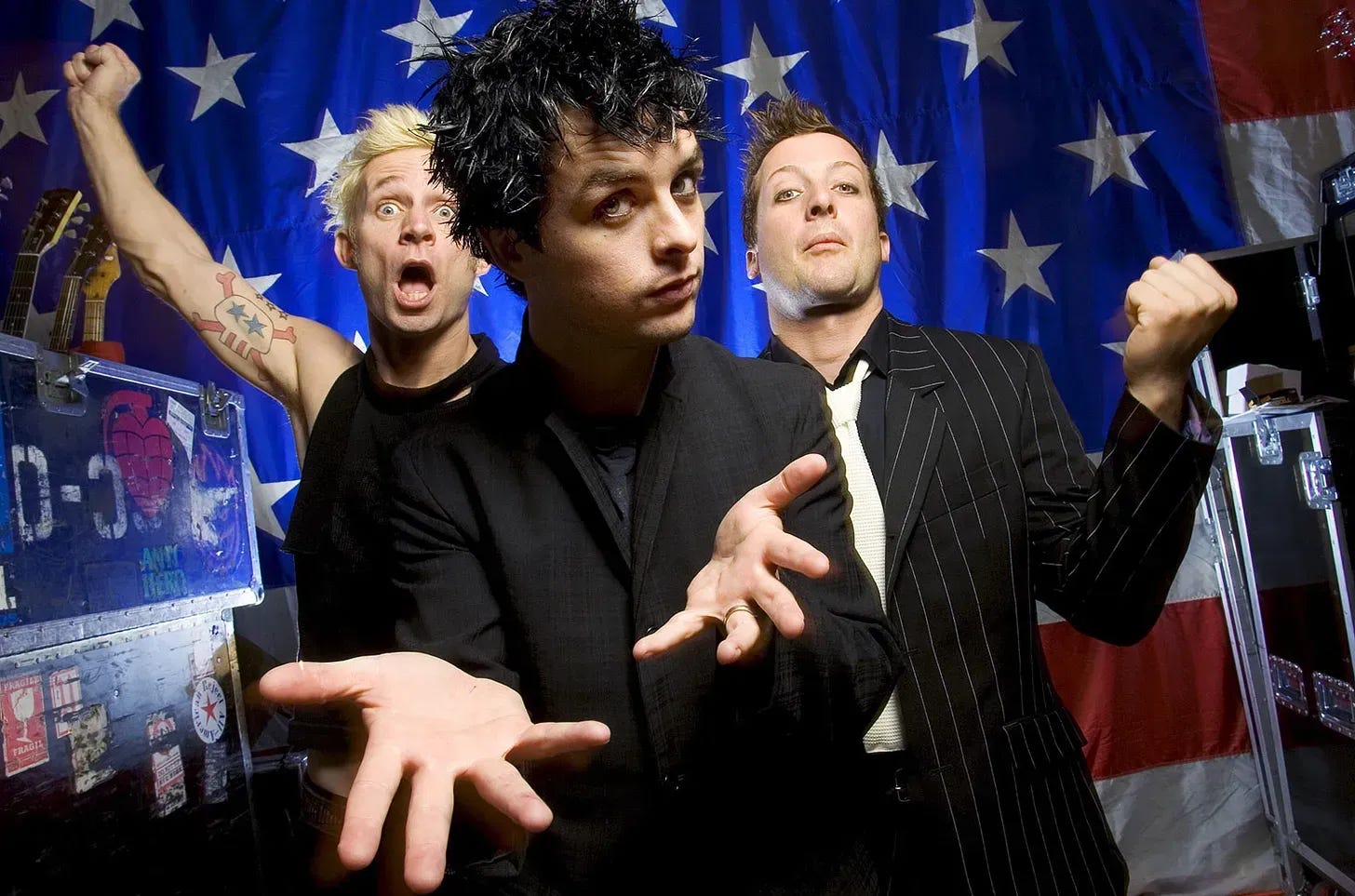
And even now, twenty years later? What is perhaps most impressive about American Idiot is that, not once, does it hold anything back.
From the opening bars of the title track, heck, from just from looking at the iconic cover art (a blood-soaked, heart-shaped hand grenade) you can feel not just an energy, as reckless as it is but a sharp focus too.
Dirnt’s angsty but tremendously efficient bass work. Cool, balancing raw emotion with blistering energy on the drums or Armstrong’s lyricism, as direct and heartfelt as his guitar’s delivery (with all three members, at various points, stepping behind the mic).
Rather famously, the album was the band fully-embracing their long-simmering political ideologies. Directly criticizing the larger American institution, specifically the Bush administration, in the wake of US involvement in the Middle East.
Perhaps it is within the “wake up and save yourselves” anthem presented in American Idiot (Now, everybody do the propaganda/And sing along to the age of paranoia) or the laments revealed behind the power-rock film of Holiday (Another protester has crossed the line/To find the money’s on the other side/Can I get another ‘Amen?’).
All things being equal, however, the band is more concerned with the smaller scale, presenting their view of the world not just how it related to things overseas at the time but domestically, as well. It is through this then, the broader thematic approach of alienation, heartache and self-discovery that has allowed American Idiot to truly endure, emerges.
A protest album through-and-through, as incorrectly held up by some? Not whatsoever. Rather, it is an examination on universal feelings, heightened by the layering its then-contemporary backdrop provides.
A timeless period piece.
As a concept album, American Idiot tells the story of the Jesus of Suburbia, a disenfranchised youth in post-9/11 America. Disillusioned and restless, he leaves what he knows behind in search of, hopefully, something better.
But in a world driven by consumerism, mass media and betrayal, as the band’s unexpected protagonist crosses paths with others (Whatshername and St.Jimmy, later revealed to be an alternate personality of Suburbia himself) it is to realize that his dreams have been constrained by the reality he was trying so hard to escape.
Bleak perhaps but given for what the band was aiming for, totally fitting.
Often dubbed a “punk rock opera”, American Idiot features two nine-minute songs, divided into movements (Jesus of Suburbia and Homecoming), those recalling their pure-punk roots (She’s a Rebel) and ballads of various character (Boulevard of Broken Dreams and Wake Me Up When September Ends - the latter, mostly removed from the album’s narrative as it discusses Armstrong’s grief over his father’s death).
American Idiot would be followed by 2009’s, 21st Century Breakdown, which, while not as tightly-woven as its predecessor is still very much indebted to the thematic groundwork it established (while being, potentially, outright stronger in its execution). Another punk-rock opera, showcasing a portrait of late-2000s America as navigated by “Christian and Gloria”, a young couple trying to find their way in the world.
And despite that success, it is a style, as of this writing, they’ve yet to return too - like the City of Kandor, trapped in a bottle.
There and close-by but forever out of reach, the band, having simply evolved past that stage of their careers, while, at the same time, still retaining the swagger it brought them.
I was just five years old when American Idiot released.
So, admittedly, the album’s in-the-moment, you-know-where-you-were effect is lost on me. Not that I can’t appreciate it, of course but my perspective, as a result, is radically different.
And an argument could be made that, yes, while committed, the band’s messaging on American Idiot is occasionally superficial, wanting the appearance of standing up to “The Man” without too much pushback (although in recent years, Green Day have altered the lyrics to the album’s title track in live performances in response to their criticism of former US President Donald Trump and his politics).
Maybe though, in the grand scheme of things, that point of contention? It doesn’t matter all too much.
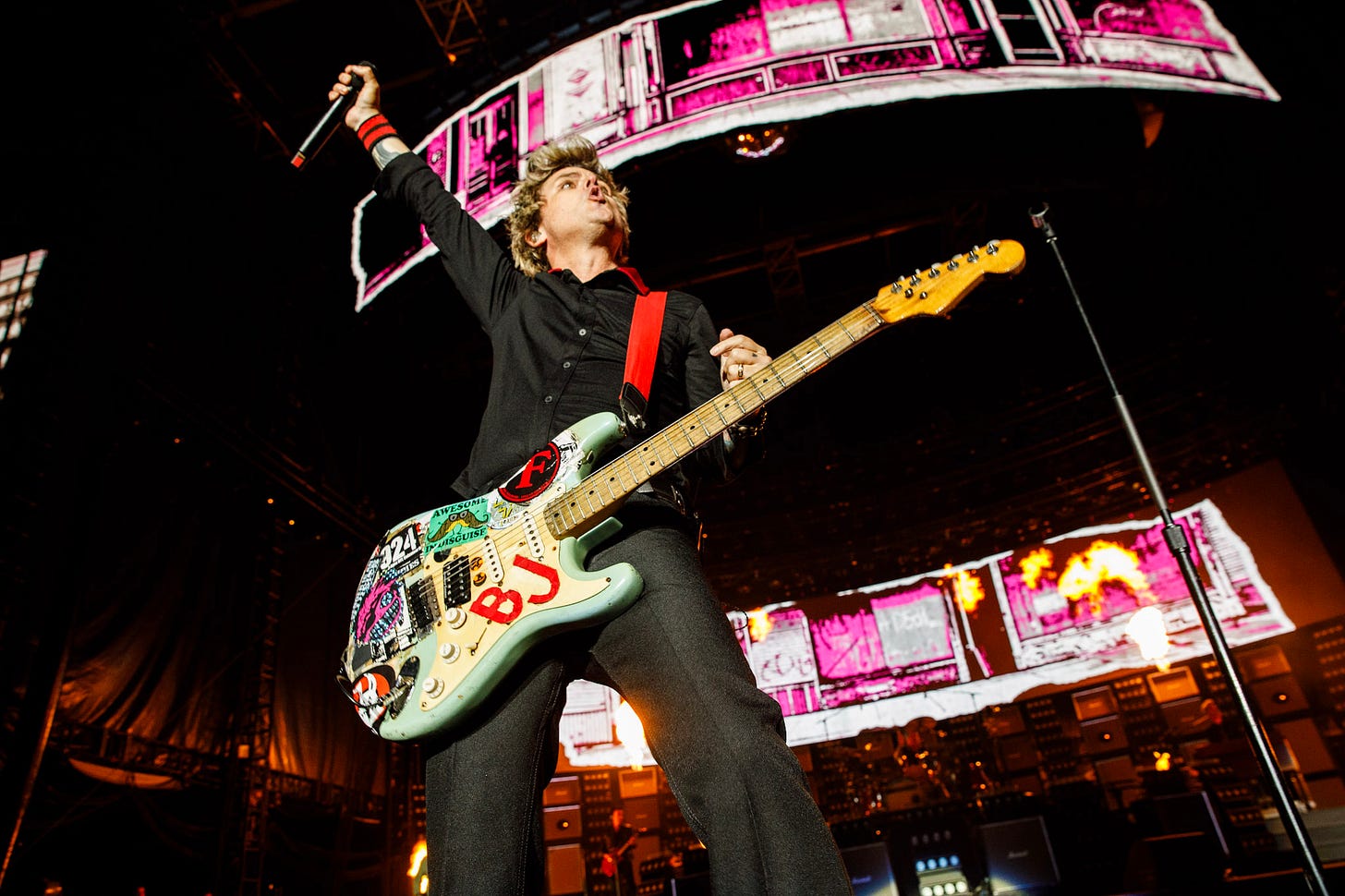
At their show in Toronto earlier this summer (in which they were flanked by Rancid, The Smashing Pumpkins and The Linda Lindas), I was fortune enough to attend.
And from the moment they stepped on stage, playing both Dookie and American Idiot, back-to-back, in their entirety? It was to see a band as strong in their musicianship as they have ever been, even following their induction into the Rock and Roll Hall of Fame in 2015.
Resting on their laurels, as it were, has simply never been an option.
So while they played tracks off their new record (2024’s Saviors) and a few other hits too, there was almost something of an unspoken understanding. That high-profile era for the band, American Idiot specifically, lives on, as attested to when all of us in that assembled crowd of 40,000-plus sang along to every word.
Giving the people something to fight for.
And there is nothing more punk than that.
In a 2016 interview, Billie Joe Armstrong and Mike Dirnt revealed that while the lost material of Cigarettes and Valentines was eventually recovered (and that the band had repurposed some of it) it was unlikely that the project would ever be released as-was, per Dirnt: “There’s always a lot in the vault but we tend to look forward rather than reaching back.”





Ahhhhh Ryan! Loved this piece! Believe it or not, the first time I saw Green Day was 30 years ago. They were part of Lollapalooza - Smashing Pumpkins were also part of the line up that year. Never imagined I would be seeing both bands again together in just a few weeks, especially at my teenage daughter's request. Life is fun and full of surprises! Thanks for building my excitement!